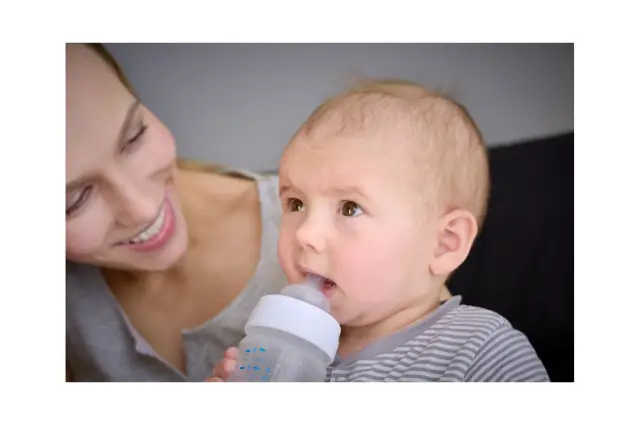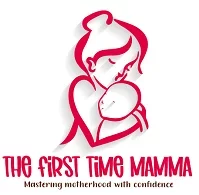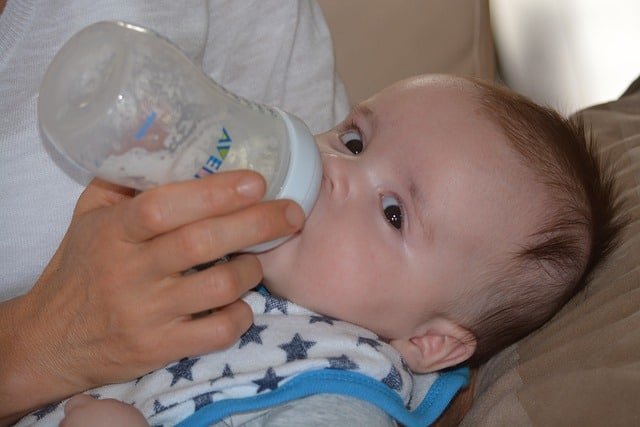Drinking from a bottle should be a piece of cake for your baby who has been hard-wired to suck on anything that touches their tiny mouth. Though sometimes the baby chews on bottle nipples instead of drinking. This act of baby chewing on a bottle instead of drinking has often been observed in babies who are exclusively breastfed during the first few weeks of their lives.
Hey! By the way… any links on this page that lead to products on Amazon are affiliate links and I earn a commission if you make a purchase. Thanks in advance – I really appreciate it! .
This bottle strike often happens without warning. For example, all this time your baby was taking the bottle of either formula or expressed breast milk like a pro, but one day they suddenly decide that they prefer to chew on the bottle instead of drinking. This causes a lot of stress for a mother as she worries about how she will feed her baby now. To solve this problem of bottle strike, find out why baby chew on bottle nipple and what to do when your baby chews on the bottle instead of drinking.
10 Things to do when your baby chews on bottle nipple instead of drinking

1) Create a friendly feeding environment. The first thing you can do when your baby keeps biting the bottle nipple is to create a friendly environment for them. As adults enjoy their food more when their surrounding is nice, so do babies. The important thing is to remain calm and relaxed as babies are very sensitive and they pick up stress when their parents are stressed. So, create an environment that is comfortable and relaxing for both you and your baby. Dim the lights, play a nice relaxing lullaby, and sit in a comfy chair.
2) Maybe the baby chews on the bottle instead of drinking because they’re not hungry enough. Babies need to be tired and just a little hungry to enjoy bottle feeding. Don’t wait till the baby cries because of hunger. This will make them fussy and cranky and they could not feed properly. Look for hunger cues. Try it when your baby is hungry but not ravenous. A frantic baby and a sense of urgency make it harder to feed. So, to prevent the baby from biting the bottle teat, make sure they are hungry before you give them the bottle.
3) Try changing the nipple of your baby’s bottle. Babies can be very picky about the shapes and sizes of the nipples. So, you might have to try different nipples first to see the best fit for your little one. Lucky for you, there’s a lot of choices available in the market when it comes to bottle nipples. If your baby uses a pacifier, then try to find a nipple similar to it. Experiment with different flow nipples and see whether your baby likes fast flow or slow flow of the milk.
4) Let the baby’s father do the bottle feeding. Breast-fed babies often struggle with taking a bottle from their mom. The baby may play with the bottle nipple instead of eating when they even hear or smell their mother nearby. So, step out of the room for the time being and let the baby’s father try to bottle feed the baby. Often if the father, or anyone but the mother offers the baby a bottle, he or she will take it.
5) Try a technique that makes use of a baby’s natural sucking reflex. These steps should help:
- Touch baby’s lips with a firm but the gentle touch of the bottle’s teat.
- Roll the teat into their mouth.
- Gently press the teat of the bottle on the center of their tongue
This will instinctively curl the sides of the baby’s tongue around the nipple. Don’t be disheartened if it doesn’t work for your baby right away. This is a new experience for a baby so it will take some time and practice to master. This is another great way to stop your breastfed baby from chewing on the bottle nipple.
6) Give them a bottle in a room that is boring. Babies often get distracted by different things in their environment and they may choose to chew on the bottle nipple instead of drinking. Find a quiet and peaceful room, away from all the distractions in the home. Avoid bright rooms with loud noises, especially one where other people may distract the baby from finishing their bottle.
7) Find the reason behind this behavior. Life happens and it can sometimes disrupt our days. Think about why your baby chews on bottle nipples. Is your baby unwell or teething? Are they going through a curious stage or one where they demand independence and autonomy? Maybe the whole family is going through a change, like moving to a new home or going back to work. Think about possible changes in your life and how they can affect their willingness to drink from a bottle. Often you’ll find that once that change has settled, they will go back to taking their bottles again.
8) Babies can have different preferences when it comes to their formula. Another thing you can do to stop a baby who keeps biting the bottle nipple is to get the right temperature for their formula. Some babies are okay with the cold temperature of the formula while others prefer it at room temperature or warm. So experiment with different temperatures e.g. if you make a formula in water that is at room temperature, try to warm it a bit and see if this trick works for your baby or not.
9) Keep your baby in the right position while feeding. Proper positioning while bottle feeding is very essential and can stop a baby who bites down on the bottle nipple. The best position for bottle feeding is to hold the baby slightly upright and snuggled into your arm. Make sure the baby’s head, neck, and body are in a straight line.
10) Don’t force your baby to take the bottle. You can let them explore the nipple with their mouth but don’t push it past their gums. This can frustrate and irritate the baby, which would in turn make them despise bottle feeding. If your baby gets upset or doesn’t eat after about 10 minutes, take a break. It’s better to leave on a happy note than end with bad feelings about feedings.
When your baby chews on the bottle instead of drinking, it happens for a number of reasons. You can try different tips and tricks highlighted above to end it. If these tips don’t seem to work for your baby, keep trying different ways until you’ve exhausted all of your options.
Don’t give up too easily. It may take some time before the baby stops chewing the bottle teat. At that time, it will click in their mind that the bottle can satisfy their hunger. But if your breastfed baby chews on a bottle nipple instead of drinking and seems to lose weight rapidly, then don’t wait for too long, talk to your pediatrician as soon as possible.

